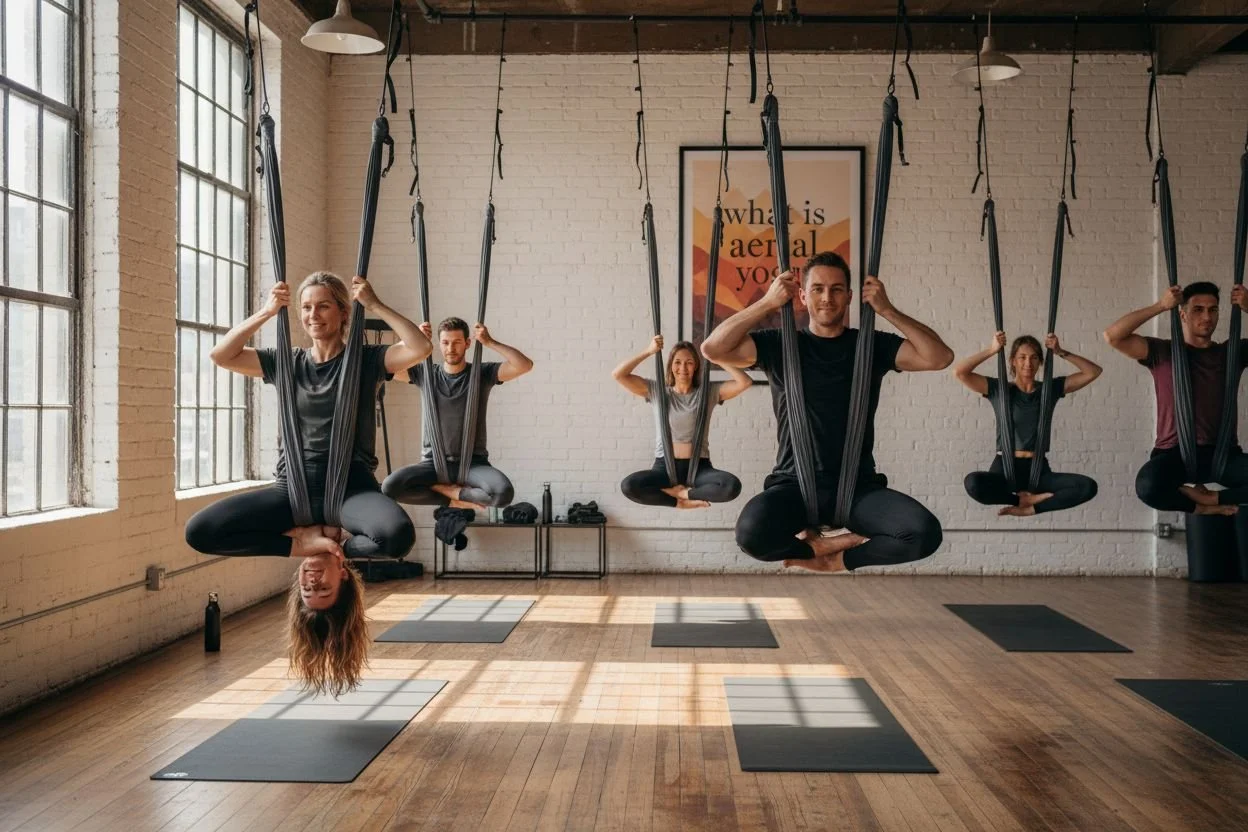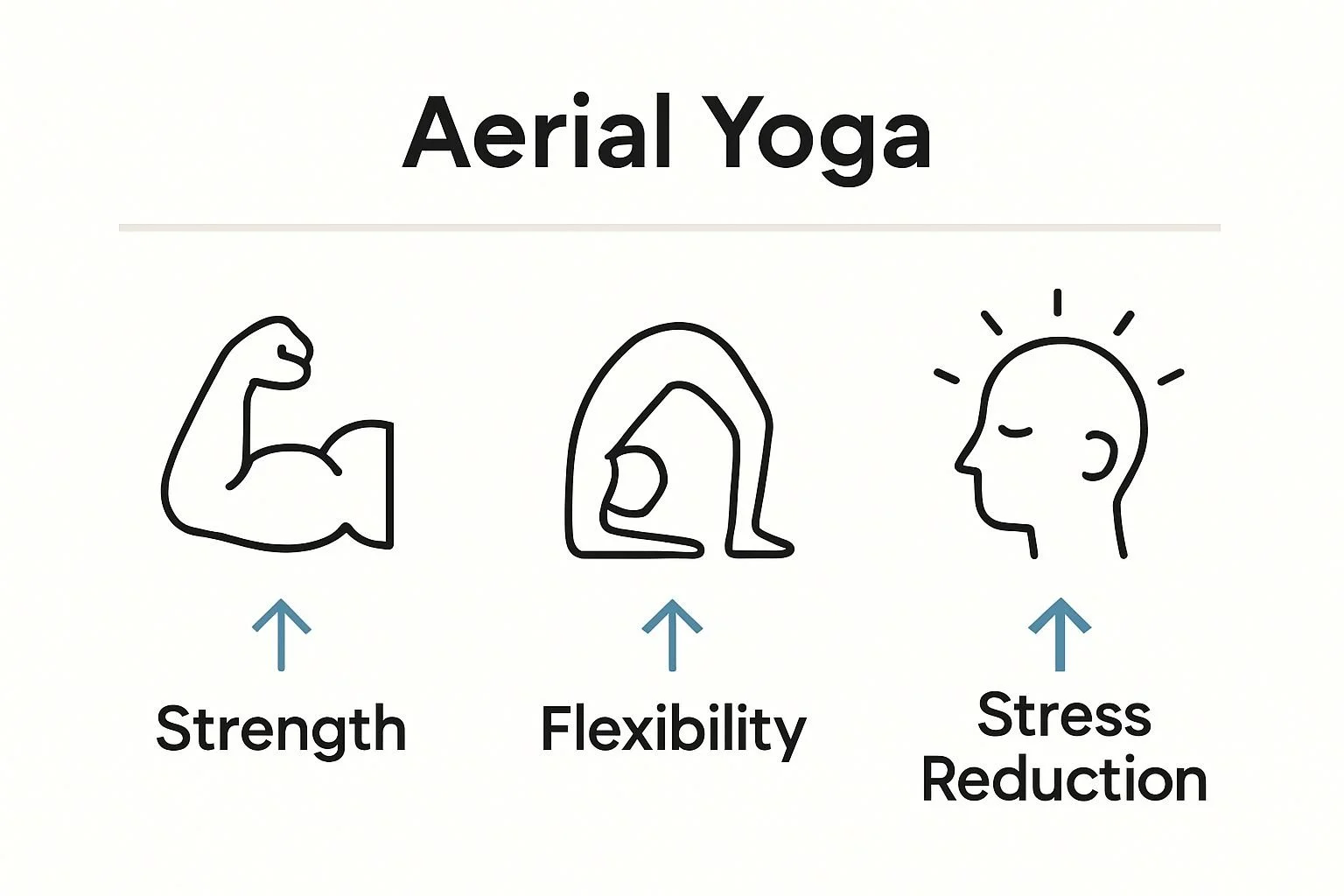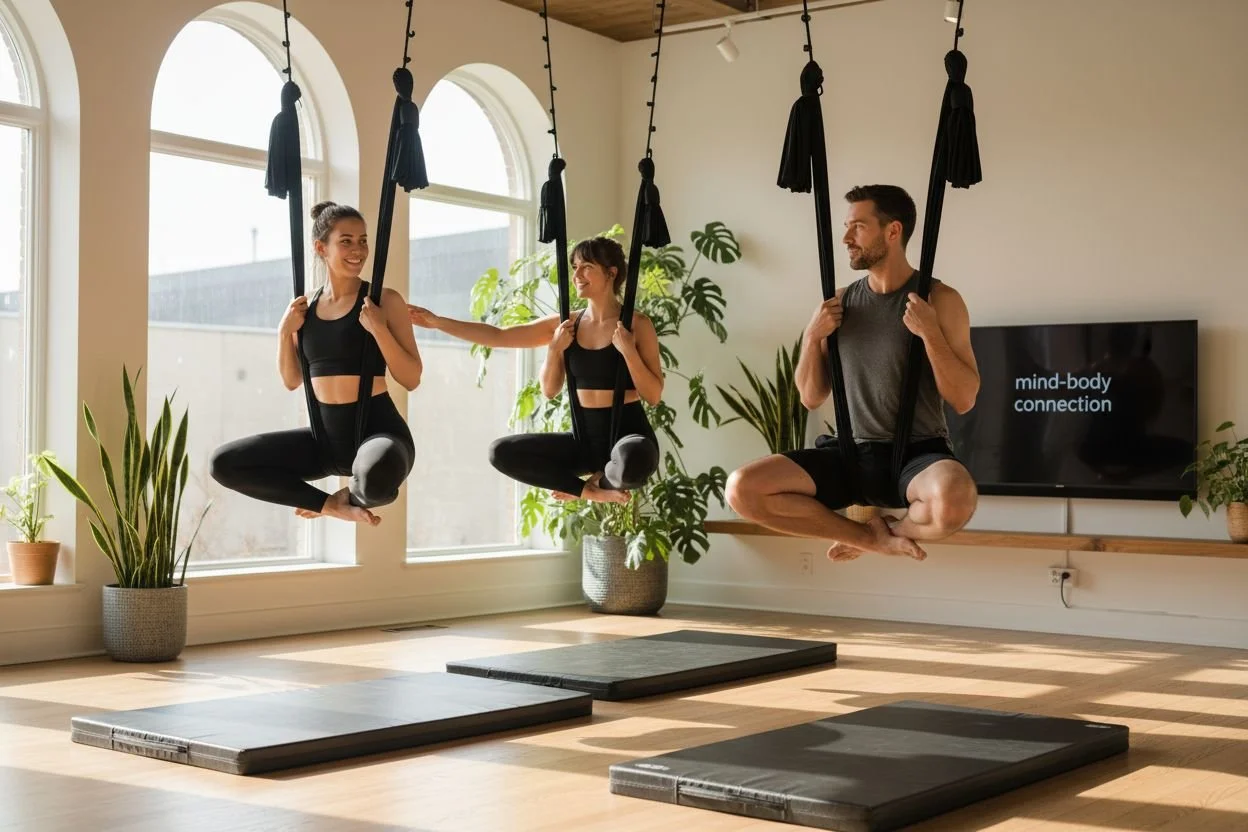What is Aerial Yoga? Understanding Its Benefits and Techniques
Heather Rice
Aerial yoga takes traditional poses and flips them upside down, quite literally, using strong fabric hammocks to hold you in midair. It might look like a circus trick at first. But research shows these moves are serious business for your body. In fact, professional-grade hammocks can safely support up to 300 pounds and enable stretches far deeper than anything on the mat. What surprises most people is how this practice isn't just about physical flexibility or acrobatics. It is about rewiring your relationship with gravity, trust, and your own sense of possibility.
Table of Contents
Quick Summary
| Takeaway | Explanation |
|---|---|
| Aerial yoga enhances physical flexibility. | Practicing in hammocks promotes deeper stretches and improves range of motion compared to traditional yoga. |
| Mental resilience develops through practice. | Aerial yoga encourages trust in oneself, reducing stress and enhancing emotional regulation as you challenge your comfort zone. |
| Proper safety and alignment are crucial. | Maintaining correct body alignment and developing core strength are essential for safe aerial yoga practice. |
| Equipment quality impacts results. | Using high-quality hammocks and setup ensures safety and maximizes the benefits of aerial yoga techniques. |
| Integrate mindfulness into movement. | Focus on body awareness during aerial yoga fosters a deeper connection between the mind and body, enhancing overall wellness. |
Defining Aerial Yoga: Principles and Basics
Aerial yoga represents a unique and dynamic fusion of traditional yoga practices with aerial arts, creating an innovative approach to movement and wellness. Unlike traditional mat-based yoga, this practice suspends practitioners in specially designed fabric hammocks or silks, allowing for greater freedom of movement and exploring yoga postures from entirely new perspectives.
The Fundamental Concept of Aerial Yoga
At its core, aerial yoga transforms standard yoga techniques by introducing gravity-defying elements. Practitioners utilize a strong, elastic fabric hammock securely anchored to the ceiling, which acts as both a support system and a versatile prop. This hammock enables participants to perform traditional yoga poses, inversions, and stretches while being partially or fully suspended above the ground.
The hammock serves multiple functions in this practice:
Provides physical support during challenging poses
Reduces gravitational pressure on joints
Allows deeper stretches and enhanced flexibility
Creates opportunities for unique movement patterns
Principles of Movement and Safety
Aerial yoga is grounded in several key principles that distinguish it from other yoga styles. Read our guide on yoga foundations to understand the broader context. Proper alignment and body awareness remain crucial, with practitioners learning to trust the hammock while maintaining precise muscle engagement. Safety is paramount, requiring practitioners to develop core strength, balance, and a nuanced understanding of their body's capabilities.
The practice combines elements from traditional yoga, Pilates, dance, and aerial arts, creating a holistic approach to physical and mental wellness. By challenging traditional boundaries of movement, aerial yoga offers practitioners a playful yet profound method of exploring physical potential and cultivating mindfulness.
Below is a comparison of traditional yoga and aerial yoga, summarizing their core differences as described in the article.
Traditional Yoga vs Aerial Yoga
| Aspect | Traditional Yoga | Aerial Yoga |
|---|---|---|
| Practice Surface | Mat on the floor | Suspended hammock |
| Joint Impact | Standard gravitational pressure | Reduced gravitational pressure on joints |
| Flexibility | Standard range of stretches | Enables deeper stretches and flexibility |
| Equipment Needed | Mat | Hammock, rigging, hardware, mat |
| Movement Range | Ground-based postures | Wider, 3D range of movement |
| Psychological Focus | Mindfulness, grounding | Trust, playfulness, risk-taking, mindfulness |
| Unique Benefits | Balance, breath control | Enhanced strength, decompression, confidence |
The Importance of Aerial Yoga for Mind and Body
Aerial yoga transcends traditional exercise by offering a comprehensive approach to wellness that addresses both physical and mental health. Learn more about holistic wellness practices through our comprehensive resources. Physical and psychological benefits intertwine in this unique practice, creating a transformative experience that challenges practitioners beyond conventional fitness routines.
Physical Health and Body Mechanics
According to research from the National Institutes of Health, aerial yoga provides significant physiological advantages. The suspended practice dramatically improves body mechanics by reducing gravitational stress and enabling deeper muscular engagement. Practitioners experience enhanced core strength, improved spinal alignment, and increased flexibility through controlled movements that traditional ground-based exercises cannot replicate.
Key physical benefits include:
Increased muscular strength and endurance
Improved joint mobility and reduced pressure
Enhanced balance and proprioceptive awareness
More effective full body conditioning
Mental Wellness and Psychological Transformation
Beyond physical fitness, aerial yoga offers profound psychological benefits. The practice requires intense concentration, mindfulness, and trust in both the hammock and personal capabilities. By challenging comfort zones and encouraging playful exploration, practitioners develop mental resilience, reduce stress, and cultivate a deeper mind body connection.
The meditative aspects of aerial yoga help practitioners release mental tension, improve emotional regulation, and create a sense of weightlessness that translates into psychological liberation. By suspending participants both physically and metaphorically, this practice enables a unique form of moving meditation that promotes inner calm and self discovery.
How Aerial Yoga Works: Techniques and Equipment
Aerial yoga introduces a sophisticated and nuanced approach to movement that requires specialized equipment and precise technical understanding. Learn more about yoga techniques to complement your understanding of this unique practice. Technical precision and equipment quality are fundamental to creating a safe and transformative aerial yoga experience.
Essential Equipment and Setup
The primary tool in aerial yoga is the hammock, a robust fabric apparatus designed to support full body weight while enabling fluid movement.
VIDEO:video_content] According to [research from Sports Medicine Open, professional aerial yoga hammocks are typically constructed from high tensile strength materials like parachute silk or nylon, capable of supporting practitioners weighing up to 300 pounds.
Critical equipment components include:
The following table summarizes the essential equipment used in aerial yoga and its purpose, helping beginners understand setup requirements.
Aerial Yoga Equipment & Purpose
| Equipment Component | Purpose |
|---|---|
| Fabric Hammock | Supports body weight, allows suspension and movement |
| Ceiling/Frame Mounting | Secures hammock to structural support |
| Adjustable Rigging Systems | Adjusts hammock height and tension |
| Carabiners & Suspension | Provides safe, stable connection points |
| Protective Floor Matting | Cushions landings for added safety |
Reinforced fabric hammock
Secure ceiling or frame mounting hardware
Adjustable rigging systems
Carabiners and suspension points
Protective floor matting
Technical Movement Principles
Aerial yoga techniques emphasize controlled, deliberate movements that leverage the hammock's support. Practitioners learn to distribute body weight strategically, using the fabric as both a support mechanism and a resistance tool. Proper alignment and gradual progression are crucial, with techniques ranging from gentle inversions to more complex aerial acrobatic sequences.
Movement techniques focus on:
Weight distribution and balance
Core engagement and muscular control
Breath synchronization with movement
Gradual skill progression
The practice requires practitioners to develop a nuanced understanding of body mechanics, spatial awareness, and trust in both equipment and personal capabilities. By combining elements of traditional yoga, dance, and gymnastics, aerial yoga creates a dynamic and immersive movement experience that challenges conventional exercise paradigms.
Key Concepts in Aerial Yoga: Benefits and Practices
Aerial yoga represents a sophisticated discipline that integrates physical movement with profound psychological exploration. Explore more about our yoga practices to understand the depth of this transformative practice. Holistic wellness and mindful movement are the cornerstone principles that elevate aerial yoga beyond conventional exercise techniques.
Physiological and Psychological Foundations
According to research from the National Institutes of Health, aerial yoga offers comprehensive health benefits that extend far beyond traditional fitness approaches. The practice uniquely combines physical conditioning with mental resilience, creating a synergistic approach to personal well-being that challenges practitioners to explore their physical and psychological boundaries.
Key physiological benefits include:
Enhanced muscular strength and flexibility
Improved spinal alignment and decompression
Increased proprioceptive awareness
Reduced joint stress and improved mobility
Mindfulness and Movement Integration
Aerial yoga transcends physical exercise by emphasizing the profound connection between body and mind. Practitioners learn to cultivate deep bodily awareness, using the suspended environment as a metaphorical and literal space for personal transformation. The hammock becomes more than equipment it serves as a tool for exploring personal boundaries, releasing physical and emotional tension, and developing trust in oneself.
Psychological practice elements focus on:
Developing mental resilience
Cultivating present moment awareness
Releasing accumulated stress
Building confidence through progressive skill development
By integrating mindful movement with physical challenge, aerial yoga offers a unique pathway to holistic wellness that encourages practitioners to reimagine their relationship with movement, gravity, and personal potential.
Experience the Transformative Power of Aerial Yoga at Amrita Yoga & Wellness
Discovering aerial yoga is just the beginning. Many readers face challenges such as limited flexibility, joint discomfort, or stress when starting traditional yoga practices. This article explains how aerial yoga addresses these issues by using foundational concepts like hammock support, mindful movement, and guided alignment for both physical and mental well-being.
Now imagine putting these principles into practice with skilled instructors in a welcoming environment. Our community at Amrita Yoga & Wellness in Philadelphia is ready to help you turn curiosity into confidence. From detailed class schedules to supportive workshops designed for all abilities, we make it easy to begin your journey—even if you are brand new to aerial yoga.
Ready to feel lighter in body and mind? Reserve your spot today and experience firsthand how our approach to aerial yoga can help you stretch deeper, build strength, and relieve daily stress. Visit our main site for class info, event details, and simple sign-up options. Join a community that believes in meaningful movement and lifelong well-being.
Frequently Asked Questions
What is aerial yoga and how does it differ from traditional yoga?
Aerial yoga combines traditional yoga poses with the support of a suspended hammock. This unique approach allows practitioners to experience poses in new ways, reducing stress on the joints and enabling deeper stretches. Consider trying a beginner class to see the differences firsthand.
What are the physical benefits of practicing aerial yoga?
Practicing aerial yoga enhances muscular strength, improves spinal alignment, and increases flexibility. Additionally, it reduces joint stress and enhances body awareness. To experience these benefits, aim for 2-3 aerial yoga sessions per week.
How do I get started with aerial yoga techniques?
To start with aerial yoga techniques, find a local studio that offers introductory classes. During these classes, you'll learn proper techniques, movements, and how to use the hammock safely. Join a class to ensure you’re utilizing correct form from the beginning.
Is aerial yoga safe for everyone?
Aerial yoga is generally safe for most people, but it is important to consult with a healthcare provider if you have existing injuries or medical conditions. Start with beginner classes to learn foundational movements and safety tips before progressing. Check with your instructor about any personal concerns you may have.
How does aerial yoga benefit mental wellness?
Aerial yoga contributes to mental wellness by promoting mindfulness, reducing stress, and enhancing focus. The practice encourages deep concentration and playfulness, which can help enhance mental resilience. Commit to practicing regularly to strengthen the mind-body connection and alleviate mental tension.
What kind of equipment do I need for aerial yoga?
For aerial yoga, the primary equipment is a specialized hammock or silk, designed to support your full body weight safely. You may also need secure mounting hardware and a soft mat for additional safety. Before starting, ensure your studio is equipped with high-quality hammocks and supports.



